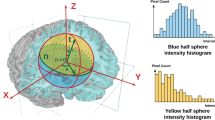Abstract
The manual production of vector maps from digital imagery can be a time consuming and costly process. Developing tools to automate this task for specific features, such as roads, has become an important research topic. The purpose of this paper was to present a technique for the semi-automatic extraction of multiple pixel width river features appearing in high resolution satellite imagery. This was accomplished using a two stage, multi-resolution procedure. Initial river extraction was performed on low resolution (SPOT multi-spectral, 20 m) imagery. The results from this low resolution extraction were then refined on higher resolution (KFA1000, panchromatic, 5 m) imagery to produce a detailed outline of the channel banks. To perform low resolution extraction a cost surface was generated to represent the combined local evidence of the presence of a river feature. The local evidence of a river was evaluated based on the results of a number of simple operators. Then, with user specified start and end points for the network, rivers were extracted by performing a least cost path search across this surface using the A* algorithm. The low resolution results were transferred to the high resolution imagery as closed contours which provided an estimate of the channel banks. These contours were then fit to the channel banks using the dynamic contours (or snakes) technique.
Similar content being viewed by others
References
A.A. Amini, T.E. Weymouth, and R.C. Jain. “Using dynamic programming for solving variational problems in vision,” IEEE Transactions on Pattern Analysis and Machine Intelligence, Vol. 12(9):855-867, 1990.
M. Barzohar, M. Cohen, I. Ziskind, and D. Cooper. “Fast robust tracking of curvy partially occluded roads in clutter in aerial images,” in A. Gruen, E.P. Baltsavias, and O. Henricsson (Eds.), Automatic Extraction of Man-Made Objects from Aerial and Space Images (II). Switzerland: Birkhauser Verlag, 277-286, 1997.
M.R. Dobie, P.H. Lewis and M.S. Nixon. “Curvilinear network extraction from remotely sensed image,” in IAPR Workshop on Machine Vision Applications (IAPR MVA'94), December 13–15, Kawasaki, Japan, 123-126, 1994.
M.A. Fischler, J.M. Tenenbaum, and H.C. Wolf. “Detection of roads and linear structures in low-resolution aerial imagery using a multisource knowledge integration technique,” Computer Graphics and Image Processing, Vol. 15:201-223, 1981.
D. Geman and B. Jedynak. “An active testing model for tracking roads in satellite images,” IEEE Transactions on Pattern Analysis and Machine Intelligence, Vol. 18(1):1-14, 1996.
R.C. Gonazalez and R.E. Woods. Digital Image Processing. Addison-Wesley: U.S.A., 1992.
A. Gruen and H. Li. “Semi-automatic road extraction by dynamic programming,” ISPRS Internation Archives of Photogrammetry and Remote Sensing, 30(3/1):324-332, 1994.
A. Gruen and H. Li. “Semi-automatic linear feature extraction by dynamic programming and LSB-snakes,” Photogrammetric Engineering and Remote Sensing, Vol. 63(8):985-995, 1997.
R.P. Grzeszczuk and D.N. Levin. “'Brownian Strings': Segmenting images with stochastically deformable contours,” IEEE Transactions on Pattern Analysis and Machine Intelligence, Vol. 19(10):1100-1114, 1997.
B. Guindon. “Computer-based aerial image understanding: A review and assessment of its application to planimetric information extraction from very high resolution satellite image,” Canadian Journal of Remote Sensing, Vol. 23(1):38-47, 1997.
M. Kass, A. Witkin, and D. Terzopoulos. “Snakes: active contour models,” International Journal of Computer Vision, Vol. 1:321-331, 1988.
S. Kirkpatrick, C.D. Gelatt Jr., and M.P. Vecchi. “Optimization by simulated annealing,” Science, Vol. 220(4598):671-680, 1983.
T.M. Lillesand and R.W. Kiefer. Remote Sensing and Image Interpretation, 2nd Ed. John Wiley and Sons: New York, 1987.
T. Matsuyama. “Knowledge-based aerial image understanding systems and expert systems for image processing,” IEEE Transactions on Geoscience and Remote Sensing, Vol. 3:305-316, 1987.
D.M. McKeown and J.L. Denlinger. “Cooperative methods for road tracking in aerial imagery,” in IEEE Computer Vision and Pattern Recognition, June 5–9, Ann Arbor, Michigan, 662-672, 1988.
D.M. McKeown, W.A. Harvey, and L.E. Wixson. “Automating knowledge acquisition for aerial image interpretation,” Computer Vision, Graphics, and Image Processing, Vol. 46:37-81, 1989.
N. Merlet and J. Zerubia. “New prospects in line detection by dynamic programming'” IEEE Transactions on Pattern Analysis and Machine Intelligence, Vol. 18(4):426-431, 1996.
M. Nagao and T. Matsuyama. A Structural Analysis of Complex Aerial Photographs. Plenum Press: New York: Plenum Press, 1980.
R. Nevatia and K.R. Babu. “Linear feature extraction and description,” Computers Graphics and Image Processing, Vol. 13:257-269, 1980.
G. Storvik. “A Bayesian approach to dynamic contours through stochastic sampling and simulated annealing,” IEEE Transactions on Pattern Analysis and Machine Intelligence, Vol. 16(10):976-986, 1994.
J. Wang and P.J. Howarth. “Edge following as graph searching and Hough transform algorithms for lineament detection,” in IGARSS '89, Vol. 1, July 10–14, Vancouver, B.C., 93-96, 1989.
D.J. Williams and M. Shah. “A fast algorithm for active contours and curvature estimation,” Computer Vision, Graphics, and Image Processing: Image Understanding, Vol. 55(1):14-26, 1992.
B. Yee. “An expert system for planimetric feature extraction,” in Proceedings of IGARSS '87 Symposium, Ann Arbor, Michigan, 18–21 May, 321-325, 1987.
Y. Zhang. “A method for continuous extraction of multispectrally classified urban rivers,” Photogrammetric Engineering and Remote Sensing, Vol. 66(8): 991-999, 2000.
A. Zlotnick and P.D. Carnine. “Note: finding road seeds in aerial images,” Computer Vision, Graphics, and Image Processing: Image Understanding, Vol. 57(2):243-260, 1993.
Author information
Authors and Affiliations
Rights and permissions
About this article
Cite this article
Dillabaugh, C.R., Niemann, K.O. & Richardson, D.E. Semi-Automated Extraction of Rivers from Digital Imagery. GeoInformatica 6, 263–284 (2002). https://doi.org/10.1023/A:1019718019825
Issue Date:
DOI: https://doi.org/10.1023/A:1019718019825




